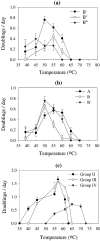Effect of temperature and light on growth of and photosynthesis by Synechococcus isolates typical of those predominating in the octopus spring microbial mat community of Yellowstone National Park
- PMID: 16391090
- PMCID: PMC1352173
- DOI: 10.1128/AEM.72.1.544-550.2006
Effect of temperature and light on growth of and photosynthesis by Synechococcus isolates typical of those predominating in the octopus spring microbial mat community of Yellowstone National Park
Abstract
Previous molecular analysis of the Octopus Spring cyanobacterial mat revealed numerous genetically distinct 16S rRNA sequences from predominant Synechococcus populations distantly related to the readily cultivated unicellular cyanobacterium Synechococcus lividus. Patterns in genotype distribution relative to temperature and light conditions suggested that the organisms contributing these 16S rRNA sequences may fill distinct ecological niches. To test this hypothesis, Synechococcus isolates were cultivated using a dilution and filtration approach and then shown to be genetically relevant to natural mat populations by comparisons of similarities of 16S rRNA genes and 16S-23S internal transcribed spacer (ITS) regions. Most isolates were identical or nearly identical at both loci to predominant mat genotypes; others showed 1- to 2-nucleotide differences at the 16S rRNA locus and even greater difference in ITS sequences. Isolates with predominant mat genotypes had distinct temperature ranges and optima for growth that were consistent with their distributions in the mat. Isolates with genotypes not previously detected or known to be predominant in the mat exhibited temperature ranges and optima that were not representative of predominant mat populations and also grew more slowly. Temperature effects on photosynthesis did not reflect temperature relations for growth. However, the isolate with the highest temperature optimum and upper limit was capable of performing photosynthesis at a higher temperature than other isolates. Growth rate and photosynthetic responses provided evidence for light acclimation but evidence of, at best, only subtle light adaptation.
Figures





References
-
- Allewalt, J. A. 2004. Temperature and light adaptations of Synechococcus isolates from a hot spring microbial community. M.S. thesis. Montana State University, Bozeman, MT.
-
- Altschul, S. F., W. Gish, W. Miller, E. W. Myersand, and D. Lipman. 1990. Basic local alignment search tool. J. Mol. Biol. 215:403-410. - PubMed
-
- Cohan, F. M. 2002. What are bacterial species? Annu. Rev. Microbiol. 56:457-487. - PubMed
Publication types
MeSH terms
Substances
Associated data
- Actions
- Actions
- Actions
- Actions
- Actions
- Actions
- Actions
- Actions
- Actions
LinkOut - more resources
Full Text Sources
Other Literature Sources
Molecular Biology Databases

